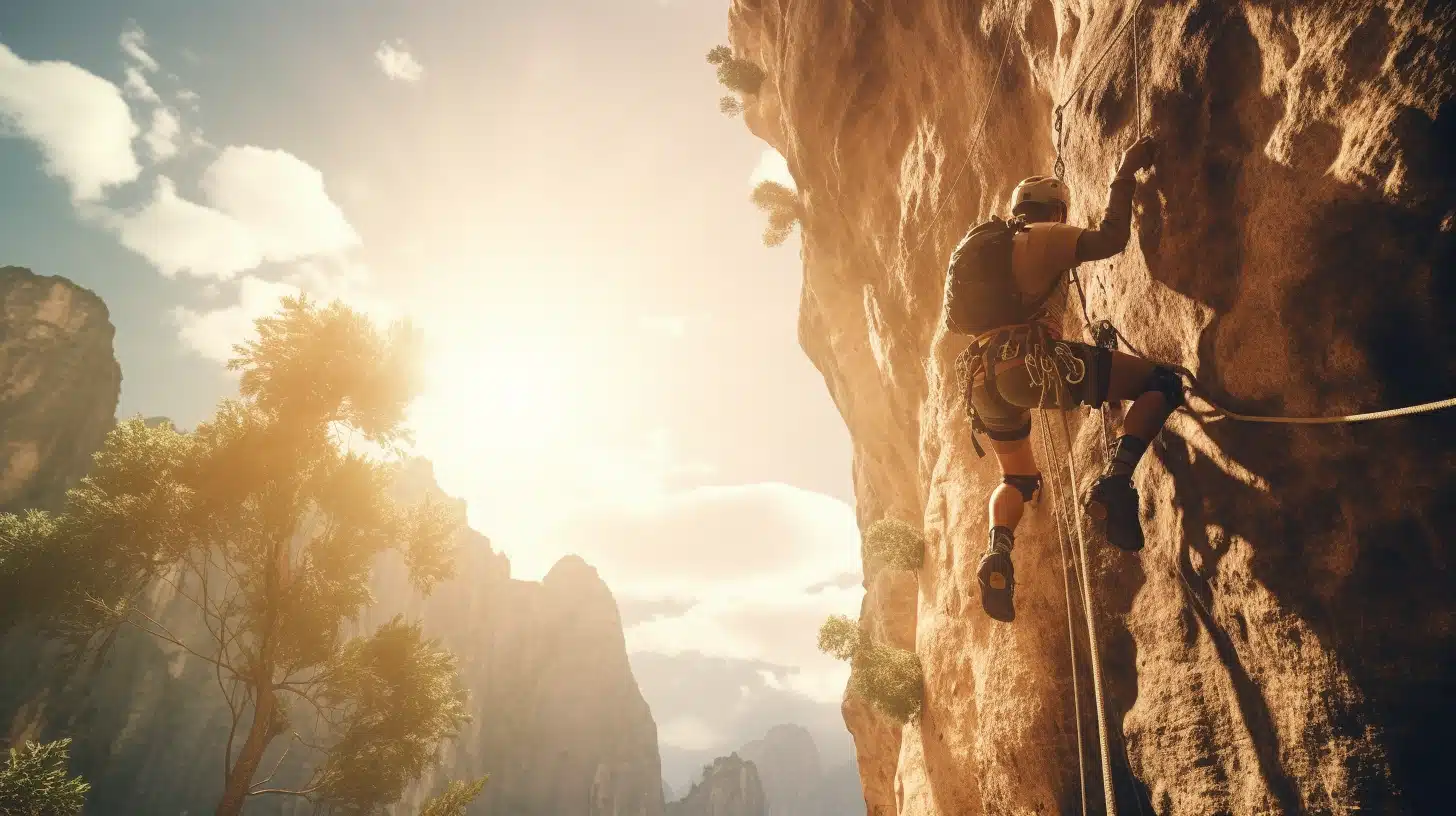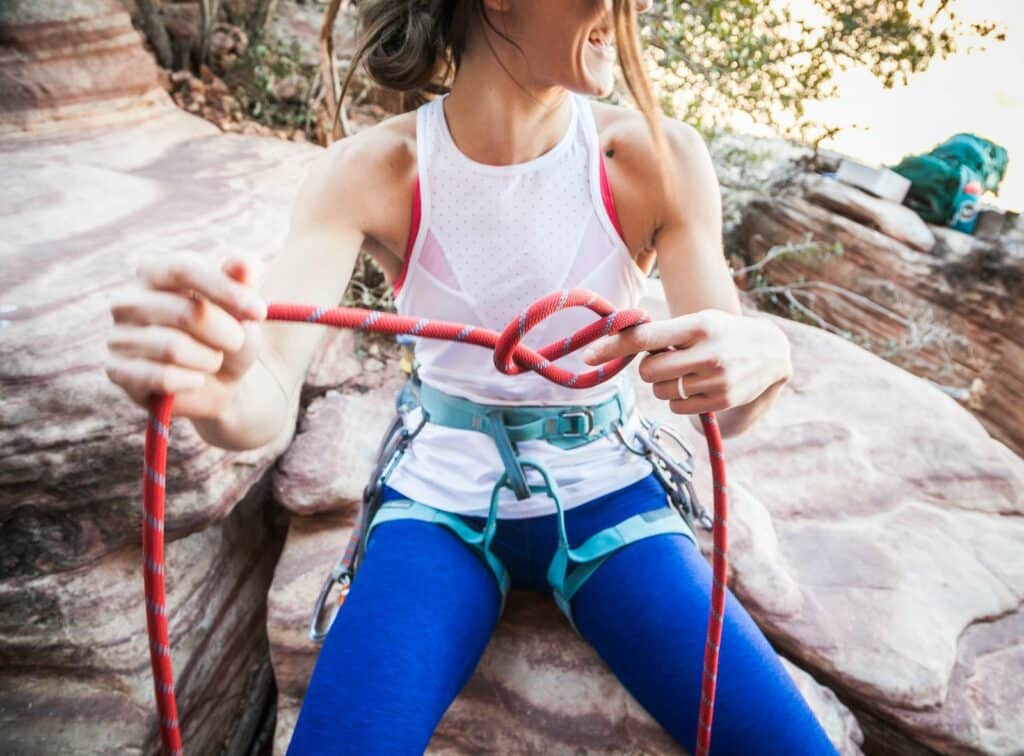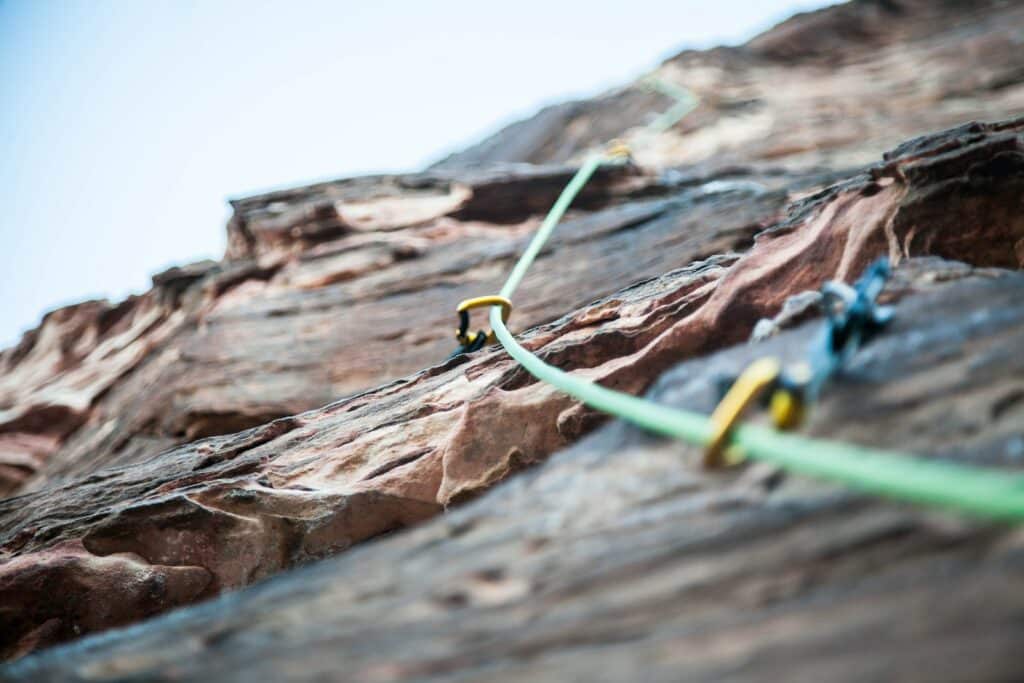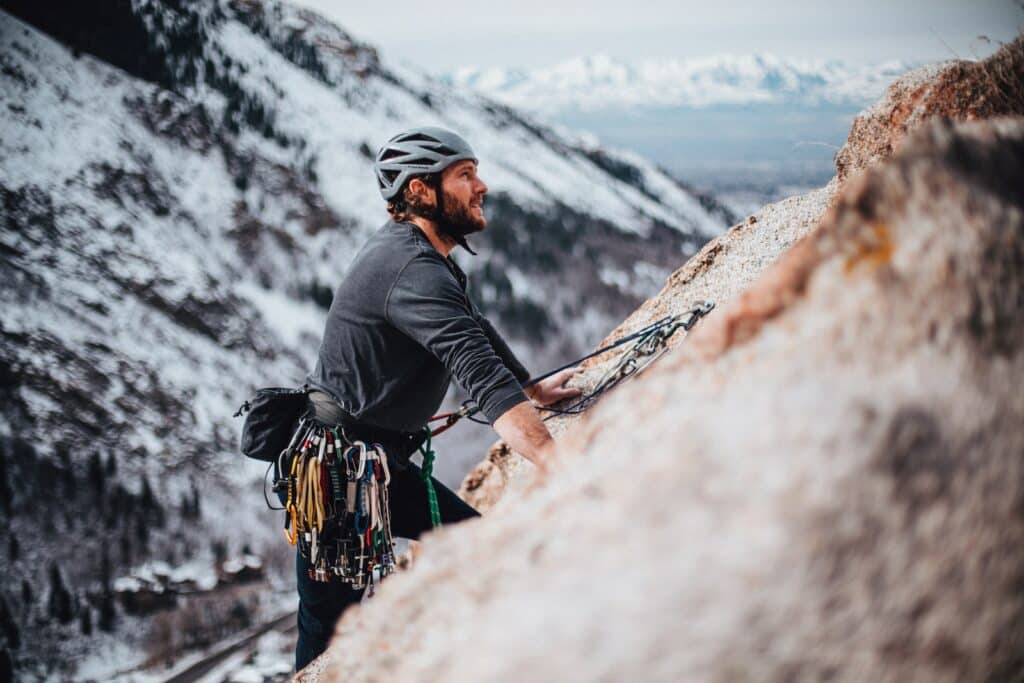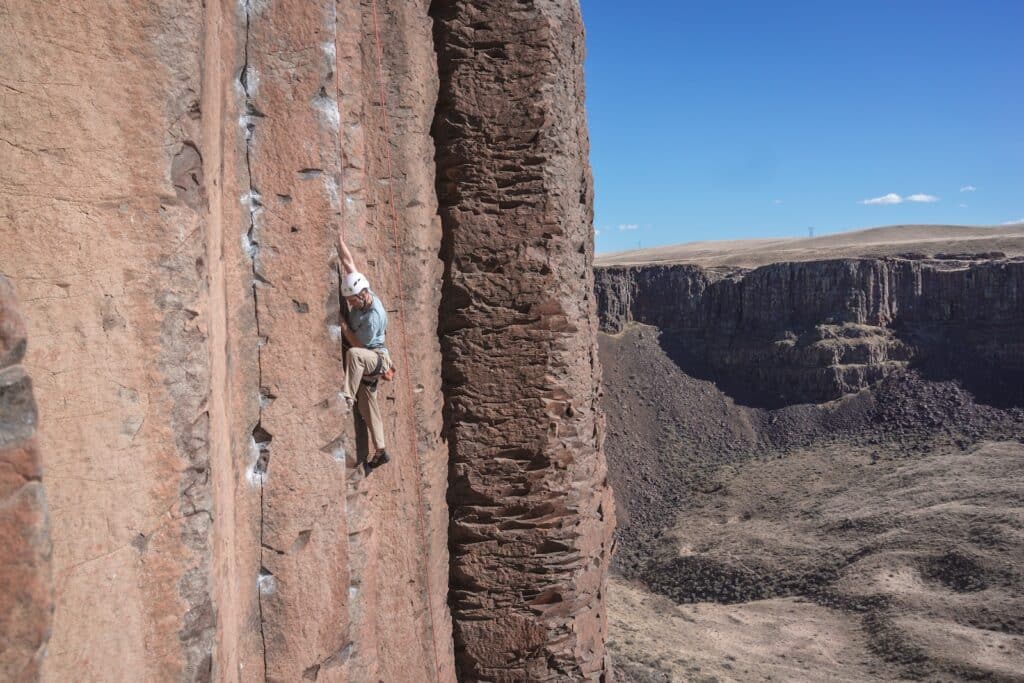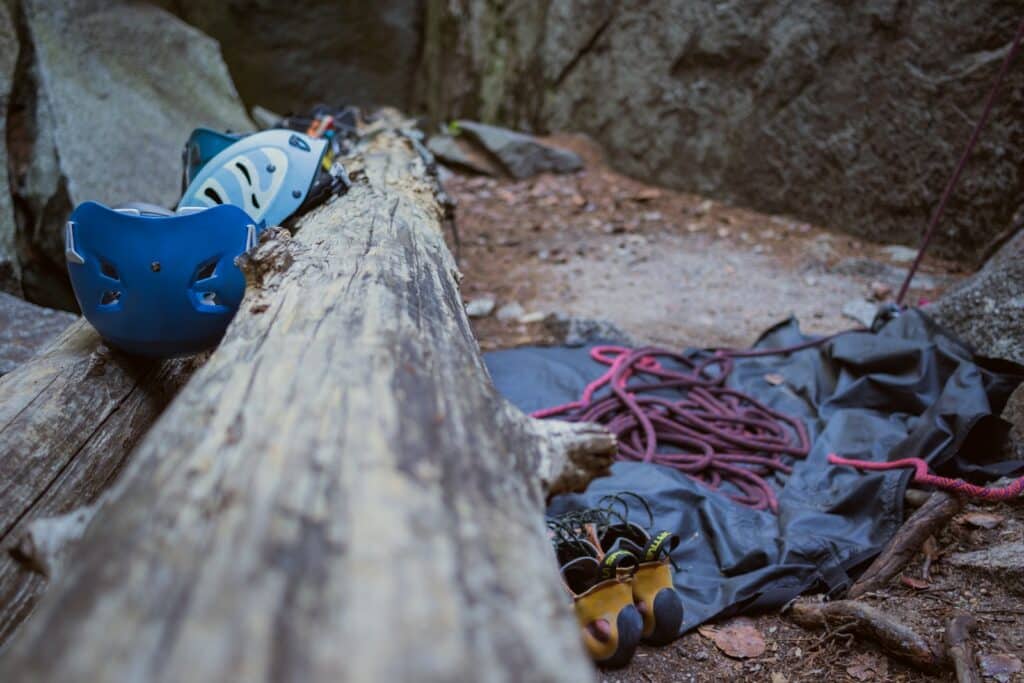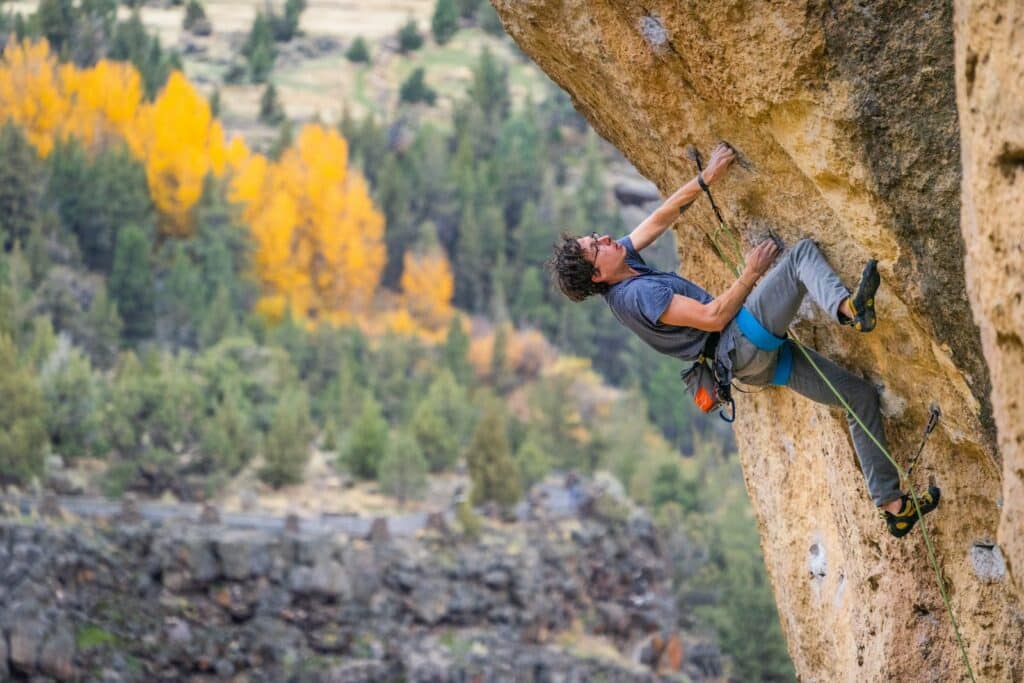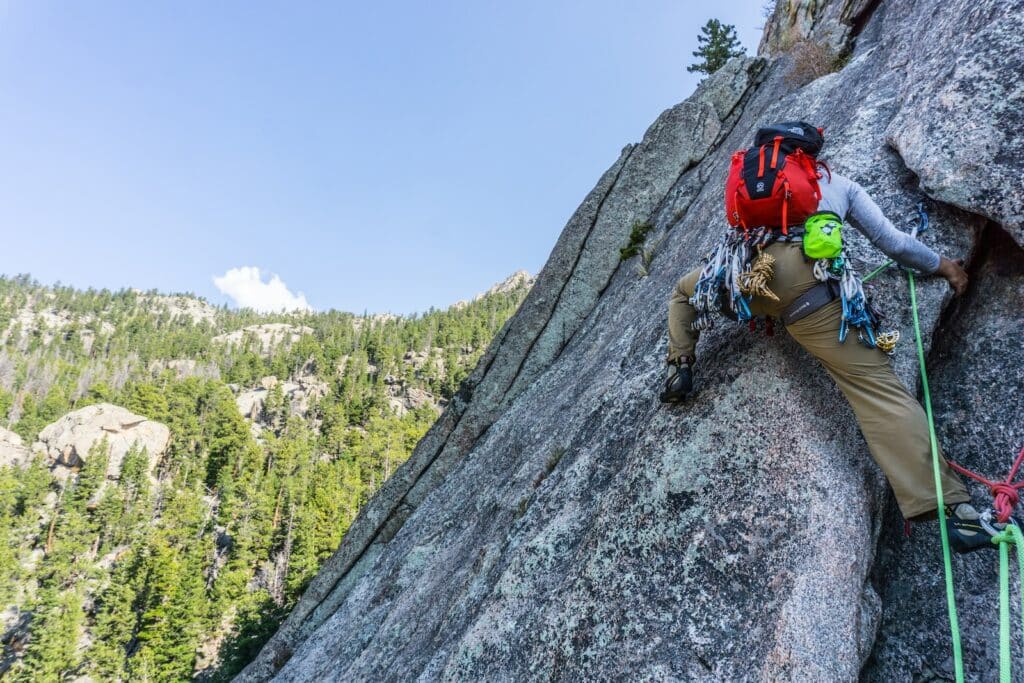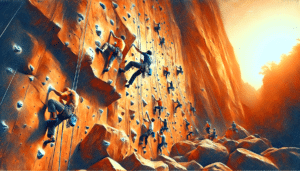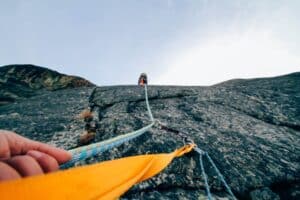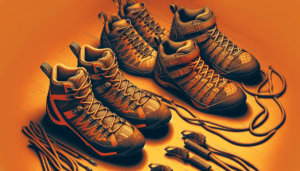Table of Contents
ToggleIntroduction to Trad Climbing
What is Trad Climbing?
Trad climbing, short for traditional climbing, is a style of climbing that involves placing gear into cracks and other features of the rock to protect against falls (Rock About). Unlike other climbing techniques, such as sport climbing, where the route is pre-equipped with fixed bolts, trad climbers rely on their own gear placements for protection. This requires climbers to carry a variety of equipment, including nuts, cams, and hexes, and to assess the rock to determine suitable placements (REI).
Traditional climbing provides a greater sense of adventure and self-reliance compared to other forms of climbing. It demands a higher level of skill and experience, as climbers must be able to assess the rock and make safe gear placements accordingly (Rock About). Trad climbers need to build their own anchors and belay stances using gear like cams, nuts, and hexes (REI).
Benefits of Trad Climbing
Trad climbing offers a unique set of benefits for those who are drawn to the sport. Here are some of the advantages:
- Sense of Adventure: Trad climbing allows climbers to explore new routes and tackle uncharted territory. It offers the opportunity to experience the thrill of creating your own path and conquering challenging climbs.
- Self-Reliance: Unlike sport climbing, where the route is pre-determined with fixed bolts, trad climbers must rely on their own gear placements for protection. This self-reliance fosters confidence and independence on the rock.
- Problem-Solving Skills: Trad climbing requires climbers to assess the rock and choose the right gear placements. This enhances problem-solving skills and critical thinking abilities as climbers navigate the route and make decisions on the spot.
- Versatility: Trad climbing can be done on a wide range of rock formations, including cracks, slabs, chimneys, and offwidths. This versatility allows climbers to explore diverse climbing environments and develop a well-rounded skill set.
- Connection with Nature: Trad climbing often takes place in natural and remote settings, providing a deeper connection with the natural world. Climbers can appreciate the beauty of the surroundings and immerse themselves in the outdoor experience.
While trad climbing offers numerous benefits, it’s important to note that it also carries a higher level of risk compared to bolted sport climbing. Climbers must possess the necessary skills, experience, and knowledge to assess the rock and make safe gear placements (Wikipedia). Proper training, mentorship, and a strong understanding of safety protocols are essential for a safe and enjoyable trad climbing experience.
To learn more about trad climbing, including essential gear, techniques, and safety tips, visit our articles on trad climbing gear, trad climbing techniques, and trad climbing safety.
Getting Started with Trad Climbing
If you’re ready to venture into the world of trad climbing, it’s essential to have the right gear and equipment. Trad climbing involves carrying a rack of various pieces of gear, such as nuts, cams, and hexes, which climbers use to create anchor points and protect themselves from falls (REI). In this section, we’ll discuss the essential gear for trad climbing and how to build your trad climbing rack.
Essential Gear for Trad Climbing
To embark on a trad climbing adventure, you’ll need a range of gear to ensure your safety and success on the wall. Here are the essential items you should have in your trad climbing kit:
1. Climbing Helmet
A climbing helmet is crucial for protecting your head from falling rocks or accidental impacts. Choose a helmet that fits well and provides ample coverage to keep you safe during your climb. Make sure to check for any certifications or safety standards when selecting a helmet.
2. Climbing Harness
A well-fitting climbing harness is essential for securely attaching yourself to the rope and providing comfort during your ascent. Look for a harness that offers proper padding and adjustability for a personalized fit. It’s important to regularly inspect your harness for any signs of wear and tear.
3. Climbing Shoes
Investing in a good pair of climbing shoes is vital to maximize your grip and footwork on the rock. Choose shoes that fit snugly, providing a balance between comfort and performance. Different climbing styles may require specific shoe designs, so consider the type of climbing you’ll be doing before making a purchase.
4. Belay Device
A belay device is a vital piece of equipment for controlling the rope during belaying. Choose a belay device that suits your preferred belaying style and is compatible with the diameter of your climbing rope. Make sure to practice proper belaying techniques and familiarize yourself with the instructions for your specific device.
5. Carabiners
Carabiners are essential for connecting various pieces of gear and creating anchor points. Look for sturdy and lightweight carabiners that are rated for climbing. Different types of carabiners serve different purposes, such as locking carabiners for securing critical connections.
6. Slings and Runners
Slings and runners are versatile pieces of equipment used for extending protection, building anchors, and managing rope drag. They come in various lengths and materials, such as nylon or dyneema. Having a selection of slings and runners with different lengths can be beneficial for various climbing situations.
For a comprehensive list of trad climbing gear and recommendations, check out our article on trad climbing gear.
Building Your Trad Climbing Rack
Building a well-rounded trad climbing rack involves selecting and organizing the appropriate gear for your climb. The specific gear you’ll need will depend on the type of route, rock type, and the level of difficulty you’re attempting. Here are some essential items to consider including in your trad climbing rack:
1. Nuts
Nuts, also known as nuts or stoppers, are passive protection devices that are wedged into cracks to create secure anchor points. They come in various sizes and shapes to fit different crack widths. Having a range of nuts in your rack will allow you to adapt to different crack sizes you encounter.
2. Cams
Cams, also called camming devices or friends, are active protection devices that expand inside cracks to create secure placements. They consist of multiple lobes connected to a stem and are available in different sizes. Cams are versatile and can be used in a wide range of crack sizes.
3. Hexes
Hexes, also known as hexcentrics or chocks, are passive protection devices that resemble hexagonal prisms. They are placed in cracks and can be used as an alternative to nuts or cams. Hexes are particularly useful in larger cracks and irregularly shaped features.
4. Quickdraws
Quickdraws consist of two carabiners connected by a sewn sling. They are used to attach the rope to bolts or gear placements. Having an assortment of quickdraws in your rack ensures you can efficiently clip into protection as you climb.
5. Slings and Cordage
Slings and cordage are versatile pieces of gear that can be used for building anchors, extending protection, or creating equalized systems. They provide flexibility and adaptability in various climbing scenarios. Consider having a range of sling lengths and cordage thicknesses in your rack.
Remember, building a trad climbing rack is a personal preference, and the specific gear you choose will depend on your climbing style, experience level, and the nature of your climb. It’s essential to gain knowledge and experience in gear placement and anchor building techniques to ensure your safety while trad climbing.
For more information on trad climbing techniques and tips, check out our article on trad climbing techniques.
Lead Climbing in Trad Climbing
In trad climbing, the lead climber plays a critical role in navigating the route and ensuring the safety of the climbing party. Let’s explore the role of the lead climber and the process of placing gear and creating anchor points.
The Role of the Lead Climber
The lead climber takes on the responsibility of ascending the climbing route first while placing gear to protect themselves and their climbing partners. They must possess good route-finding skills to identify available gear placements and make quick decisions based on the rock features and conditions. The lead climber sets the pace and establishes the route for the rest of the climbing party.
Leading a traditional climb requires a higher level of skill and experience compared to other climbing techniques. The lead climber must assess the rock for suitable gear placements, taking into consideration factors such as rock quality and crack sizes. They must also have a solid understanding of trad climbing gear and how to properly use cams, nuts, hexes, and other types of protection.
Lead climbers face unique risks compared to climbers in other styles. They must be prepared for the potential of falling twice the distance to their last point of protection (Wikipedia). Effective communication and trust between the lead climber and the second, who is responsible for belaying, are essential to minimize the length of a fall (Wikipedia).
Placing Gear and Creating Anchor Points
During the ascent, the lead climber carefully selects and places gear into cracks and other features of the rock to create anchor points for protection. This process involves assessing the rock for quality and stability to ensure that the gear placements are secure. Placing gear correctly is crucial for the safety of the climbing party.
The lead climber relies on their knowledge of gear placement techniques to determine the appropriate size and type of protection for each section of the route. They consider factors such as crack sizes, rock features, and the strength of the placements. By distributing the gear strategically, the lead climber ensures that the climbing party is protected in case of a fall.
Creating anchor points is another vital aspect of trad climbing. Once the lead climber reaches a suitable stance or belay ledge, they establish a secure anchor system using a combination of gear placements, slings, and carabiners. This anchor system provides a safe and stable point for the rest of the climbing party to join and continue the ascent.
For climbers new to trad climbing, it is essential to seek guidance from experienced climbers or participate in courses to learn proper gear placement techniques and anchor building skills. Safety should always be the top priority when placing gear and creating anchor points.
By understanding the role of the lead climber and the process of placing gear and creating anchor points, climbers can embark on their trad climbing adventures with confidence and safety in mind. Remember to consult local climbing resources, seek professional instruction, and gain experience gradually to develop the necessary skills for trad climbing.
Assessing Rock Quality in Trad Climbing
As a trad climber, it is crucial to assess the quality of the rock before placing gear and embarking on a climb. The safety and success of your climb depend on your ability to evaluate the rock for suitable gear placements. Here are two important aspects to consider when assessing rock quality in trad climbing:
Evaluating Rock for Gear Placements
Before placing gear, it is essential to examine the rock for stability and strength. Loose or unstable rock can compromise the integrity of your gear placements and lead to potential falls. Take the following steps to evaluate the rock:
- Visual Inspection: Carefully observe the rock surface for any signs of loose flakes, fractured sections, or crumbly areas. Look for solid, well-attached rock features that can securely hold your gear.
- Tapping: Gently tap the rock with your hand or a climbing tool to listen for any hollow or dull sounds. A solid and reliable gear placement should produce a clear, resonant sound.
- Testing: Apply pressure to the rock and test its stability. If the rock shifts or flexes significantly, it may not be suitable for gear placements. Opt for more stable sections of rock with reliable features for secure placement.
Remember, rock quality can vary greatly depending on the climbing area and route. Always prioritize your safety by being cautious and thorough in assessing the rock before committing to gear placements.
Identifying Suitable Crack and Feature Sizes
In trad climbing, cracks and features in the rock are critical for placing protective gear. Different crack and feature sizes require specific gear sizes to ensure proper placement. Here are some guidelines for identifying suitable crack and feature sizes:
- Width and Depth: Measure the width and depth of cracks to determine the appropriate size of gear, such as cams or nuts. Ensure that the crack is wide and deep enough to accommodate the gear without being overly loose or flaring.
- Features: Look for solid features on the rock surface, such as pockets, edges, or flakes, that can accept gear placements. Assess the size and shape of these features to select suitable gear.
- Camming Range: For camming devices, consider the range of sizes they can accommodate. Match the size of the camming device to the crack or feature size to ensure a secure placement.
By accurately assessing the crack and feature sizes, you can confidently select the right gear for each placement, enhancing your safety and stability during the climb.
Remember, developing the skills to evaluate rock quality takes time and experience. Seek guidance from experienced climbers, take courses, and continually practice assessing rock quality to refine your judgment. Always prioritize safety and exercise caution when making gear placements during trad climbing.
Techniques and Skills for Trad Climbing
Trad climbing requires a higher level of skill and experience compared to other climbing techniques. To excel in trad climbing, it’s important to develop specific techniques and skills that will enhance your climbing ability and keep you safe on the wall. In this section, we will explore two essential aspects of trad climbing: route-finding and making quick decisions and adjustments.
Route-Finding in Trad Climbing
Route-finding is a crucial skill for trad climbers. Unlike sport climbing, where the route is preplanned and marked with preplaced bolts, trad climbers must assess the rock and plan their own route to reach the summit or the next ledge or site. This requires a deep understanding of the climbing area and the ability to read the rock for potential gear placements.
As a trad climber, it’s important to develop a keen eye for identifying crack systems, suitable features, and weaknesses in the rock that can accommodate gear placements. Careful observation and evaluation of the rock will help you identify the best line to follow and make efficient progress.
To improve your route-finding skills, it’s essential to climb a variety of routes and gain experience in different types of rock formations. By exposing yourself to different climbing scenarios, you’ll become more adept at reading the rock and identifying potential gear placements. Consulting guidebooks, speaking with experienced climbers, and studying route descriptions can also provide valuable insights into the best routes to take.
Making Quick Decisions and Adjustments
Trad climbing often presents unexpected challenges that require quick decisions and adjustments while climbing. As a lead climber, you may encounter situations where the intended gear placement is not feasible or secure. In such cases, you must be able to think on your feet and adapt your plan accordingly.
Developing the ability to make quick decisions and adjustments comes with experience and a deep understanding of gear placement and climbing techniques. It’s important to stay calm and focused, assessing the situation and evaluating alternative options. This may involve searching for alternative gear placements, adjusting your climbing strategy, or even reassessing the route entirely.
To build your decision-making and adjustment skills, practice climbing on different types of rock formations and in various weather conditions. Push yourself to climb routes that challenge your problem-solving abilities and require split-second decisions. Climbing with more experienced trad climbers can also provide valuable mentorship and guidance in developing these skills.
Remember, trad climbing is about more than just physical strength and technical ability. It requires mental agility, adaptability, and the ability to think critically in challenging situations. With time and practice, you’ll become more confident in making quick decisions and adjustments while maintaining a safe and enjoyable climbing experience.
By honing your route-finding skills and developing the ability to make quick decisions and adjustments, you’ll be better equipped to navigate the complexities of trad climbing. These skills, combined with a solid understanding of gear placement and rock evaluation, will enhance your trad climbing experience and help you tackle a wide range of climbing challenges with confidence and competence.
For more information on trad climbing techniques, tips, and gear, be sure to check out our articles on trad climbing techniques and trad climbing tips.
Safety Tips for Trad Climbing
When engaging in trad climbing, it is essential to prioritize safety at all times. As a trad climber, you need to be aware of the potential risks and take the necessary precautions to minimize them. Here are two important safety tips to keep in mind:
Proper Use of Protection Gear
Trad climbing relies on placing protection gear, such as cams, nuts, and slings, to create anchor points and protect against falls. It is crucial to understand the correct use of this gear to ensure your safety. Take the time to learn how to properly place and assess the integrity of each piece of protection equipment.
Before using any gear, carefully inspect it for any signs of wear or damage. Follow the manufacturer’s instructions and guidelines for each piece of gear, ensuring that you are using it correctly. Regularly check and maintain your gear to ensure its effectiveness and reliability.
Additionally, it is important to understand the limitations of different types of protection gear. Each piece has its own strengths and weaknesses, and knowing how to choose the right gear for the specific rock type and climbing conditions is crucial for your safety. For more information on trad climbing gear, check out our article on trad climbing gear.
Climbing with a Competent Partner
Climbing with a competent and experienced partner is of utmost importance in trad climbing. Your partner should have a solid understanding of trad climbing techniques, gear placements, and safety protocols. A skilled partner can provide guidance, support, and backup in case of any unexpected situations.
Before climbing, discuss your plans and objectives with your partner, ensuring that you are on the same page. Regularly communicate and maintain good teamwork throughout the climb, keeping each other informed about potential hazards and changes in conditions.
It is also vital to have a clear understanding of each other’s abilities and limitations. Be honest about your experience level and communicate any concerns or uncertainties. Trust and effective communication between climbing partners are essential for a safe and successful trad climbing experience.
By following these safety tips and continually expanding your knowledge and skills, you can enjoy the challenges and rewards of trad climbing while minimizing risks. Remember, safety should always be your top priority in any climbing endeavor.
Continue your trad climbing journey by exploring additional topics such as trad climbing techniques and trad climbing tips.
Trad Climbing vs. Sport Climbing
When it comes to rock climbing, there are different styles and techniques to explore. Trad climbing and sport climbing are two popular forms of the sport, each with its own unique characteristics. Understanding the key differences between these styles can help you make an informed decision about which one is right for you.
Key Differences Between Trad and Sport Climbing
- Protection: Trad climbing, short for traditional climbing, requires the climber to place their own protection as they ascend the route. This involves using various pieces of gear, such as chocks and camming devices, which need to be strategically placed along the route. In contrast, sport climbing has preplaced bolts that provide protection as the climber ascends the route (REI). These bolts are already fixed to the rock, eliminating the need for the climber to place their own protection.
- Route Planning: In trad climbing, climbers must plan their own route to get to the summit or the next ledge. This requires assessing the rock face, identifying suitable crack and feature sizes, and finding areas where gear can be securely placed (Pelican). Sport climbing, on the other hand, follows a preplanned route with preplaced bolts. The route is already established, and climbers can focus on the physical aspects of climbing without the added task of route planning.
- Safety Considerations: Trad climbers need to know how to secure themselves using anchors, as there are no preplaced bolts. This requires knowledge of anchor building techniques and the ability to assess rock quality for reliable gear placements (Pelican). Sport climbing, especially with preplaced bolts, is considered safer, making it a better option for beginners who may not have extensive experience with anchor building and gear placement.
- Location: Trad climbing is typically done outdoors on actual mountainsides or rock faces, offering the thrill of climbing in natural environments. Sport climbing, on the other hand, can be done both outdoors and indoors. Climbing gyms provide prebuilt routes and overhangs with preplaced bolts, allowing climbers to practice and develop their skills in a controlled environment (Pelican).
Choosing Between Trad and Sport Climbing
The choice between trad climbing and sport climbing depends on various factors, including personal preferences, experience level, and the type of climbing you enjoy. Here are a few considerations to help you make an informed decision:
- Experience Level: Trad climbing requires a higher level of technical knowledge and skills, including gear placement and anchor building. If you’re new to climbing or have limited experience, starting with sport climbing can be a great way to build foundational skills and gain confidence.
- Risk Tolerance: Trad climbing typically involves more risk and requires climbers to take responsibility for their own protection. If you prefer a more controlled and predictable climbing experience, sport climbing with its preplaced bolts may be a better fit.
- Access to Climbing Areas: Consider the availability of climbing areas and resources in your location. If you have easy access to outdoor climbing areas with suitable rock formations, trad climbing can provide a rewarding experience. On the other hand, if you live in an urban area with limited outdoor climbing options, sport climbing in climbing gyms can offer a convenient and accessible alternative.
- Desired Climbing Experience: Think about the type of climbing experience you are seeking. Trad climbing offers the opportunity to explore natural environments and engage in route planning, while sport climbing focuses more on physical movement and pushing your climbing limits on established routes.
Ultimately, the choice between trad climbing and sport climbing is a personal one. Many climbers enjoy both styles and may choose to pursue both depending on the location, availability of climbing partners, and their goals. Exploring both styles can help you develop a well-rounded skill set and expand your climbing horizons.
For more information on trad climbing, including gear, techniques, and safety tips, check out our articles on trad climbing gear and trad climbing techniques.
Lead Climbing in Trad Climbing
Trad climbing, is a style of climbing where climbers place gear (such as nuts, cams, and hexes) into cracks and other features of the rock to protect themselves in case of a fall (Rock About). Lead climbing is an essential aspect of trad climbing, and it involves the lead climber carefully selecting and placing gear in solid rock features to create anchor points for protection and to prevent serious injury in case of a fall (Rock About).
The Role of the Lead Climber
In trad climbing, the lead climber takes on the responsibility of placing protection gear as they ascend the route. The lead climber must have a deep understanding of gear placement, as well as the ability to assess the rock for suitable placements (REI). The lead climber carries the gear and places it as they progress, ensuring that the placements are secure and able to hold a fall.
As the lead climber, it’s crucial to carefully evaluate the rock for gear placements. This involves assessing the stability and quality of the rock, looking for cracks, pockets, or other features that can accommodate the gear (Climbing Magazine). The lead climber must also consider the size and shape of the gear needed for each placement to ensure a secure anchor point.
Placing Gear and Creating Anchor Points
When placing gear in trad climbing, it’s important to understand the different types of protection available, such as cams, nuts, and hexes. Each type of gear has its own strengths and weaknesses, and knowing when to use each one is essential for a safe and successful climb.
Cams, also known as spring-loaded camming devices (SLCDs), are versatile pieces of gear that can be placed in cracks. They expand once inserted, creating a secure anchor point. Nuts, or “stoppers,” are passive protection devices that are wedged into constrictions or cracks. Hexes, or “hexcentrics,” are hexagonal-shaped pieces of gear that can be placed in different orientations to accommodate various crack sizes.
As the lead climber, it’s important to practice proper gear placement techniques. This includes selecting the appropriate size and type of gear for each placement, ensuring that the gear is solidly seated in the rock, and equalizing the placements to distribute the load evenly (Climbing Magazine). Building a strong and secure anchor system is crucial for protecting yourself and your climbing partner.
To further enhance your trad climbing skills, consider taking courses or learning from experienced climbers who can provide guidance on lead climbing techniques, gear placement strategies, and anchor building. Remember, trad climbing requires a high level of skill and experience, so continuous learning and practice are essential for safe and enjoyable climbs.
By understanding the role of the lead climber and mastering the art of gear placement, you’ll be well on your way to becoming a confident and competent trad climber. Always prioritize safety, assess the rock quality, and make informed decisions when it comes to gear placement. Trad climbing offers a unique and rewarding experience, allowing you to explore new routes and challenge yourself both mentally and physically.

